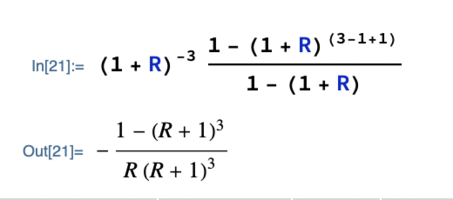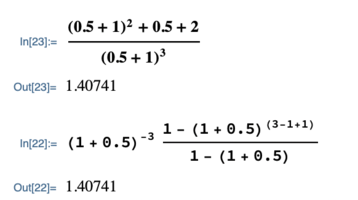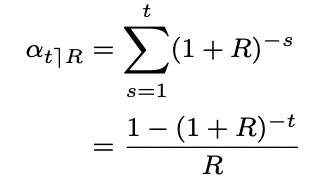You are using an out of date browser. It may not display this or other websites correctly.
You should upgrade or use an alternative browser.
You should upgrade or use an alternative browser.
rewriting of a sum
- Thread starter aw1998
- Start date
D
Deleted member 4993
Guest
I have to show the following:
View attachment 34237
by using:
View attachment 34238
I know that the first sum starts at 1 and the other at zero, therefore I have tried subtracting 1 but i did not get anywhere
Hope someone can help me to understand!
Please share your work, so that we can see whether or not you are making any mistake/s.
I FULLY agree with SK that you need to show your work, but, without even seeing it, I know that you are starting from a FALSE premise.I have to show the following:
View attachment 34237
by using:
View attachment 34238
I know that the first sum starts at 1 and the other at zero, therefore I have tried subtracting 1 but i did not get anywhere
Hope someone can help me to understand!
[math] \sum_{s=0}^t x^s = \dfrac{1 - x^{t+1}}{1 - x} \text { for } x \ne 0 \implies \\ \sum_{s=0}^{t=0} x^s = \dfrac{1 - x^{0+1}}{1 - x} = \dfrac{1 - x^1}{1 - x} = \dfrac{1 - x}{1 - x} = 1 \ne 0. [/math]
Why in the world would you think [imath]x \ne 0 \implies x^0 = 0[/imath]?
Dr.Peterson
Elite Member
- Joined
- Nov 12, 2017
- Messages
- 16,861
As I understand it, this refers to the fact that s starts at 1 in the first sum, but at 0 in the second sum, and the first term of the latter is 1. So you probably are doing something right. But, once again, we need to see what you did in order to see what you are not doing right.I have to show the following:
View attachment 34237
by using:
View attachment 34238
I know that the first sum starts at 1 and the other at zero, therefore I have tried subtracting 1 but i did not get anywhere
Hope someone can help me to understand!
I am sorry, this is my first post, i overlooked the
 ?
?
My problem is the my "s" is equal to 1, but the rule counts for s=0. I will try to show my work:
First of all, i dont know if i am using the rule correct by writing:

Here i am regering to the potens that becomes negative.
Then i was trying to subtract 1 to make up for the sum starting at s = 1, instead of s = 0 as the rule says:

Then i wanted to rewrite it, but here I ran in to troubles:

Then i am stuck, because this is not right when i tried with a numerical example:

It does not equal... Am I using the the rule wrong maybe? Or something else I am doing wrong?
I do not follow here, the rule I am given says x≠1I FULLY agree with SK that you need to show your work, but, without even seeing it, I know that you are starting from a FALSE premise.
[math] \sum_{s=0}^t x^s = \dfrac{1 - x^{t+1}}{1 - x} \text { for } x \ne 0 \implies \\ \sum_{s=0}^{t=0} x^s = \dfrac{1 - x^{0+1}}{1 - x} = \dfrac{1 - x^1}{1 - x} = \dfrac{1 - x}{1 - x} = 1 \ne 0. [/math]
Why in the world would you think [imath]x \ne 0 \implies x^0 = 0[/imath]?
My problem is the my "s" is equal to 1, but the rule counts for s=0. I will try to show my work:
First of all, i dont know if i am using the rule correct by writing:

Here i am regering to the potens that becomes negative.
Then i was trying to subtract 1 to make up for the sum starting at s = 1, instead of s = 0 as the rule says:

Then i wanted to rewrite it, but here I ran in to troubles:

Then i am stuck, because this is not right when i tried with a numerical example:

It does not equal... Am I using the the rule wrong maybe? Or something else I am doing wrong?
Dr.Peterson
Elite Member
- Joined
- Nov 12, 2017
- Messages
- 16,861
The rule doesn't apply directly, because it applies to a sum of positive exponents. So, no, you can't do this.My problem is the my "s" is equal to 1, but the rule counts for s=0. I will try to show my work:
First of all, i dont know if i am using the rule correct by writing:
View attachment 34265
Here i am referring to the power that becomes negative.
How about factoring out [imath](1+R)^{-t}[/imath] from the sum: [math]\sum_{s=1}^t(1+R)^{-s}=(1+R)^{-t}\sum_{s=1}^t(1+R)^{t-s}[/math]
Now the exponents are all non-negative; the last is zero and the first is [imath]t-1[/imath]. Can you see what to do then?
If not, try writing out the first few and last few terms.
Dr.Peterson
Elite Member
- Joined
- Nov 12, 2017
- Messages
- 16,861
Take an example. Let t=3 or 4, and write out all the terms ofAfter trying with factoring, i get to this point:
View attachment 34309
Just cant figure out how to get rid of the (1+R)^-s?
Don't really know how to use this : "Now the exponents are all non-negative; the last is zero and the first is t-1".
What is the first term? What is the last? Does that fit the rule you are applying, or do you have to turn the series around?
Don't blindly apply a formula that doesn't apply. How does it make sense to write
without a summation? What value are you supposing s has?
I tried to write it out the sum setting t= 3:

Inserting in the factered sum:

Checking if it is the same as when using the rule, t=3 and s=1( the assumption og s=1 might be wrong?) :

Using R = 0.5 in both expressions:

So the first steps are the same. But i am applying the rule wrong somewhere, but i am not sure where?

Inserting in the factered sum:

Checking if it is the same as when using the rule, t=3 and s=1( the assumption og s=1 might be wrong?) :

Using R = 0.5 in both expressions:

So the first steps are the same. But i am applying the rule wrong somewhere, but i am not sure where?
Dr.Peterson
Elite Member
- Joined
- Nov 12, 2017
- Messages
- 16,861
The point I wanted you to see is that inI tried to write it out the sum setting t= 3:
View attachment 34375
Inserting in the factered sum:
View attachment 34376
Checking if it is the same as when using the rule, t=3 and s=1( the assumption og s=1 might be wrong?) :
View attachment 34377
Using R = 0.5 in both expressions:
View attachment 34378
So the first steps are the same. But i am applying the rule wrong somewhere, but i am not sure where?

you have a geometric series in reverse order. Use that fact to answer the original question. I'm not sure that your calculations here contribute anything.





